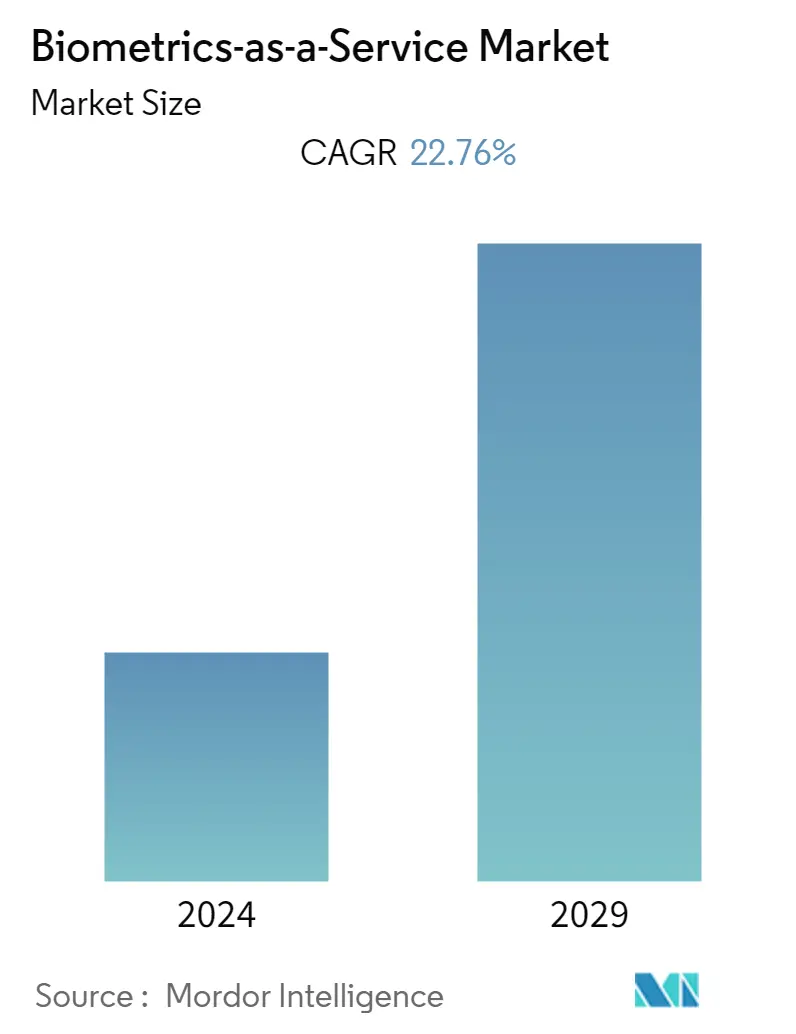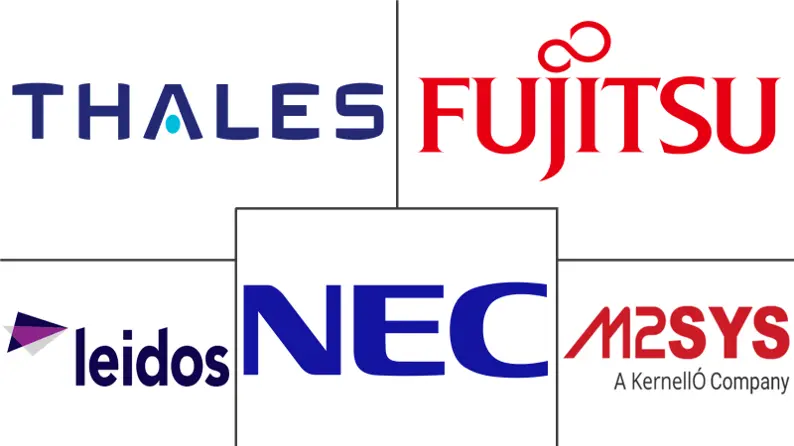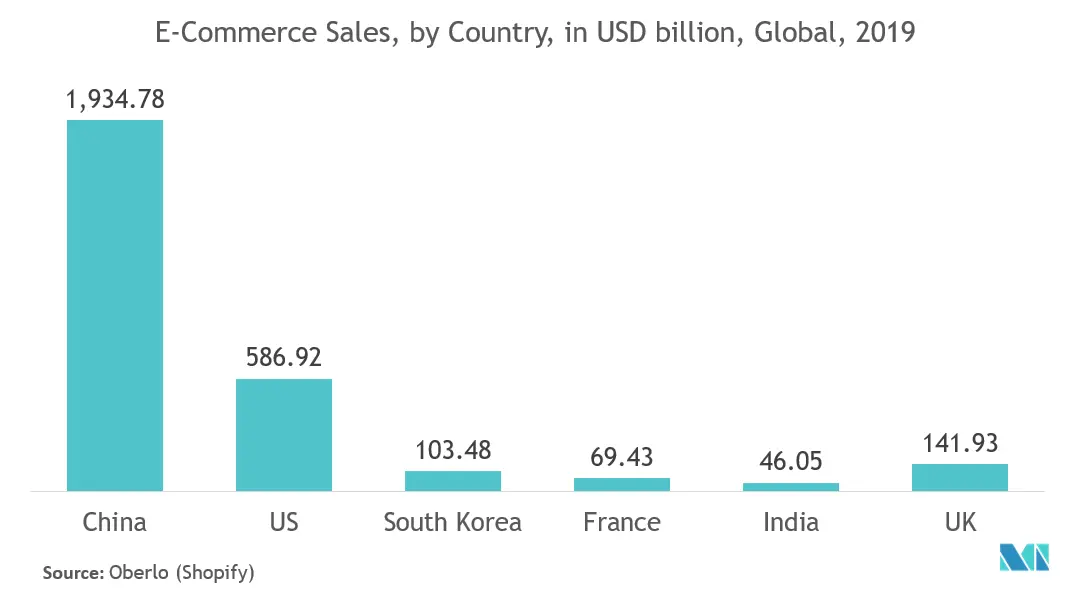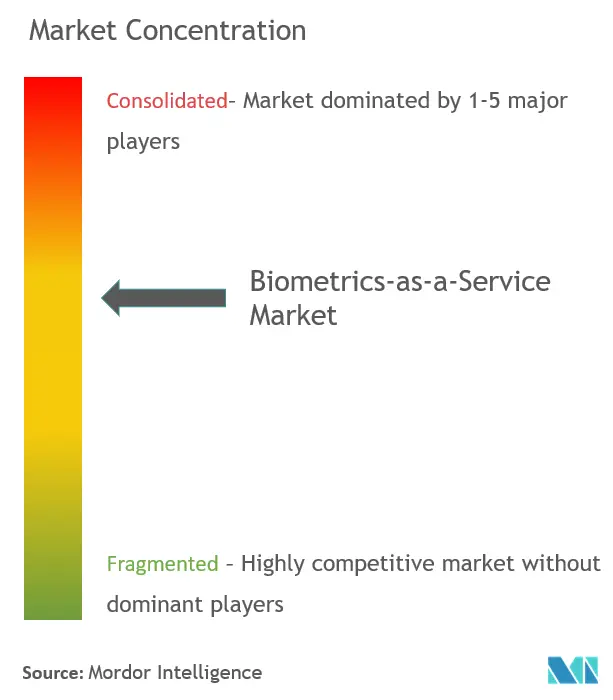Biometrics-as-a-Service Market Size

| Study Period | 2019 - 2029 |
| Base Year For Estimation | 2023 |
| CAGR | 22.76 % |
| Fastest Growing Market | Asia Pacific |
| Largest Market | North America |
| Market Concentration | High |
Major Players
*Disclaimer: Major Players sorted in no particular order |
Biometrics-as-a-Service Market Analysis
The biometrics-as-a-service market was valued at USD 4.75 billion in 2020 and is expected to reach USD 16.03 billion by 2026, registering a CAGR of 22.7% during the forecast period from 2021 to 2026. The global biometrics demand is anticipated to develop at a significant growth rate, owing to the rising number of terrorist activities, the increasing theft activities about crucial data, and information that have raised concerns regarding national security. Significant factors, such as growth in the e-passport program, government support, and extensive use in criminal identification, are expected to drive the market's growth over the forecast period majorly. The recent COVID-19 outbreak is also becoming an emerging driver for contactless biometric solutions.
- Organizations across various sectors, where security remains the primary concern, are investing heavily in their security systems, focusing on access control systems. The defense, law enforcement, and government institutions are some of the prominent users of this technology. Moreover, the soaring need to strengthen national security augmented the growth of these systems, globally. Iris recognition is used in different countries for a wide range of purposes, including passport-free automated border crossings. The biometric-as-a-service solution can be leveraged to not only tie disparate identity information across the business but also enable the integration of different types of biometrics as best suited to particular business needs and risk levels.
- One of the key trends witnessed in the market studied is a model shift in business discourse toward more privacy and fewer security threats. The end-users are increasingly expecting for integrated solutions, rather than depending on traditional methods. Consumer biometric applications have expanded rapidly over the recent years, with increased adoption of mobile devices. The consumer electronics sector is dominated majorly by security and access control devices, owing to the approval of biometric systems. Thus, it is supporting the growth of the market. For instance, WhatsApp, a popular messaging app, launched an additional privacy measure on the Android platform. The company claims that users will soon be able to secure their accounts in the form of biometric authentication through fingerprint sensors.
- Integrating biometrics with the cloud, which is the main focus area for vendors presently, enables cloud - enhanced capabilities and technologies to be assimilated on the entire biometrics' infrastructure of a service provider. For instance, in July 2019, SkyBiometry updated the version of its cloud-based face detection and recognition algorithm that included significant enhancements that make the algorithm much more accurate and allow for a broader range of facial attributes in the detection process. Further, Fujitsu partnered with ImageWare Systems (IWS) to provide Biometric-as-a-Service solutions. With a combination of Fujitsu's cloud Infrastructure-as-a-Service (IaaS) and Software-as-a-Service (SaaS), along with IWS' biometrics authentication technology, enterprises can be prepared for a BYOD workplace environment and security-enhanced services for mobile transactions.
- The COVID -19 outbreak and the nationwide lockdown have impacted many industries around the world, so does the studied market. Due to the recent COVID-19, the biometric market has witnessed a significant shift in the adoption pattern. The COVID-19 has developed a massive space for contact-free sensing solutions. Although the market is seeing a decline in touch-based technologies, the touchless technologies are now flooding the market. The trend can be seen across various end-users like offices, hospitals, airports, and secure locations that rely on fingerprint readers, card access, or manual processes. The significantly growing adoption of non -contact biometric attendance in these applications is also driving the overall market. In the last 3 - 4 months, the market has witnessed a massive decline in fingerprint recognition as many government agencies are claiming that there is a risk of infection via these commonly touched surfaces.
Biometrics-as-a-Service Market Trends
This section covers the major market trends shaping the Biometrics-as-a-Service Market according to our research experts:
Retail is Expected to Hold Significant Share
- The applications of biometrics in the retail industry are primarily for access control for employees, which may enable the retailers to curb inventory theft. With e-commerce creating an edge over the brick and mortar stores, in terms of customer experiences, retailers are deploying marketing, data, and analytics tools to enhance the customer experience. They are taking the aid of identification methods, like biometrics, for securing their customer data. Brick and mortar retailers, therefore, use biometrics to deliver customer-loyalty programs based on historical customer data (obtained by biometrics) to retain their existing customers in the competitive retail market.
- As brick and mortar retailers adopt the online business platform for new revenue streams to create an omnichannel presence, the need for securing customer data increases even more. With the consumers using mobile phones for shopping, the emergence of m-commerce (mobile-commerce), along with e-commerce, also provides scope for identity theft of customers making the payment transactions. Further, with the data streaming from all the kiosks, POS (in brick and mortar stores), and the increasing requirement for these to be integrated into a centralized source with the available customer data, Biometrics-as-a-Service is gaining prominence in the retail industry.
- In March 2019, NtechLab signed an agreement with Watcom Group which is a Russian firm specializing in the analysis of visitor flows in shopping centers and stores. The companies are planning to create solutions for retail companies' managers, who will be able to make decisions based on customers' gender, age, and emotions. The technology can also be used to track employees' working time and attendance and watch for unwanted visitors. In October 2019, the software technology company, Vsblty, signed a global reseller agreement with Sensormatic Solutions, a part of Johnson Controls, to deliver biometric shopper analytics and loss prevention solutions.
- Additionally, retailers are using biometrics to increase their supply chain efficiencies by refurbishing only those in demand. Biometrics is also being leveraged to enhance customer experience and measure and maximize retail intelligence for both retailers and major consumer brands. For instance, in July 2019, Kairos launched a plug and play data visualization and analytics solution which even includes biometric facial recognition, for retail stores to gather demographic and tracking information about customers. The solution provides data on the customer's age, gender, emotion, dwell time, and new and return visits.

North America is Expected to Hold the Largest Share
- According to the Federal Trade Commission, identity thefts related to payment and banking sectors are prominent in the United States. In turn, it would boost the adoption of advanced authentication services, such as biometrics. The United States government agencies are also engaging in the adoption of biometric technology for identification and security purposes. The use of facial recognition biometrics and personal data security is still a significant concern during the pandemic. The US Department of Homeland Security (DHS) projects to have a face, fingerprint, and iris scans of at least 259 million people in its biometrics database by 2022, with respect to a recent presentation from the agency’s Office of Procurement Operations reviewed by Quartz.
- Citing the threat of the coronavirus to the American public, the US government said in March 2020 that it would begin rapidly sending people who illegally cross the United States borders to their respective home countries and would stop the processing of undocumented migrants at the entry ports. Under the new rule, set to take effect in March 2020, Border Patrol agents will be issued biometric tools to process migrants in the field. In May 2020, DHS’s biometric advanced recognition technology system begins the road to the cloud with Homeland Advanced Recognition Technology System (HART), which is replacing DHS’s legacy Automated Biometric Identification System (IDENT); as the department’s primary system for storing and processing biometric and associated biographic information.
- In June 2020, US-based IoT network start-up, Qopper, launched two new products, The Occupancy Monitor, and the Temperature Kiosk, for helping retail and commercial businesses safely reopen following the lifting of COVID-19 restrictions. Company’s Temperature Kiosks for Touchless Check-Ins come equipped with thermographic temperature scanners to identify any individual who may have a fever, one of the symptoms of COVID-19. The kiosks are capable of facial recognition or QR code-based authentication as a form of access control for added security. They are compatible with Workforce Management Systems like Kronos for clock-in/ clock-out capabilities.
- US-based Clear, biometrics firm that has developed biometric-based solutions to bypass travel documents at the security check-in airports has now shifted their focus into COVID-19 screening. The company is rolling out health e-pass that will link health data to verified IDs so that businesses can track their employees. In 2020, US-based Cognizant launched touchless authorization processing for healthcare service providers, and Infosys launched contact-less baggage management solutions for a North American airline. In the US, many citizens are still concern about adopting facial recognition technology. Industry experts claim that facial recognition for specific purposes at airports may be justified, but indefinite storage of health, travel, and other data is illegitimate.

Biometrics-as-a-Service Industry Overview
The biometrics-as-a-service market is highly competitive and consists of several key players like Thales Group, Fujitsu Limited, M2SYS, NEC Corporation, and many more. However, the market remains fragmented, with many players trying to occupy the share. Their ability to continually innovate their products and services by investing significantly in research and development has allowed them to gain a competitive advantage over other players.
- April 2020 - Fujitsu Frontech North America Inc. announced the acquisition of Fulcrum Biometrics, LLC, Texas-based biometric hardware, software, and solutions provider. This transaction represents a significant commitment by the company to strengthen its biometrics business in North America and global identity management markets, including multi-factor authentication mandates imposed by new state and federal laws regarding financial institutions and healthcare providers' ability to share patient information.
- January 2020 - Thales applied innovative Field-Programmable Gate Array (FPGA) technology, designed for massive parallel data processing, to power its Biometric Matching System. With Gemalto's commercial off-the-shelf FPGA solution, Thales allows the number of servers to be cut in half and dramatically limits the overall carbon footprint. Border Agencies introducing Entry/Exit systems and various other government agencies requiring real-time response could now benefit from low latency biometric data processing.
Biometrics-as-a-Service Market Leaders
-
M2SYS Technology - KernellÓ Inc.
-
Fujitsu Limited
-
NEC Corporation
-
Thales Group (Gemalto NV)
-
Leidos Holdings Inc.
*Disclaimer: Major Players sorted in no particular order

Biometrics-as-a-Service Market Report - Table of Contents
1. INTRODUCTION
- 1.1 Study Assumptions and Market Definition
- 1.2 Scope of the Study
2. RESEARCH METHODOLOGY
3. EXECUTIVE SUMMARY
4. MARKET DYNAMICS
- 4.1 Market Overview
-
4.2 Industry Attractiveness - Porter's Five Force Analysis
- 4.2.1 Bargaining Power of Suppliers
- 4.2.2 Bargaining Power of Consumers
- 4.2.3 Threat of New Entrants
- 4.2.4 Threat of Substitute Products
- 4.2.5 Intensity of Competitive Rivalry
5. MARKET DYNAMICS
-
5.1 Market Drivers
- 5.1.1 Need to Secure Increasing Online Transaction
- 5.1.2 Increased Sophistication of Security Threat
- 5.1.3 Governments Adopting Technology to Secure Citizens
-
5.2 Market Challenges
- 5.2.1 Security of Data Stored with Third Party (Cloud)
- 5.2.2 Lack of Multi -Party Authentication System
-
5.3 Market Opportunities
- 5.3.1 Increasing Adoption of Cloud -based Services by Enterprises
6. KEY TECHNOLOGICAL TRENDS
- 6.1 Voice And Speech Recognition To Be At The Forefront Of Technological Change
- 6.2 Rise Of Mobile Biometrics And Surge In Facial Recognition Technology
- 6.3 Continuous Authentication To Emerge As The Key Trend
- 6.4 Research Efforts To Focus On New Areas, Such As Heartbeat Detection And Temperature Through Wearables
7. ASSESSMENT OF COVID-19 IMPACT ON THE INDUSTRY (Various Use Cases and Product Launches Across the World)
8. MARKET SEGMENTATION
-
8.1 By Application
- 8.1.1 Site Access Control
- 8.1.2 Time Recording
- 8.1.3 Mobile Application
- 8.1.4 Web and Workplace
-
8.2 By Scanner Type
- 8.2.1 Fingerprint Recognition
- 8.2.2 Iris Recognition
- 8.2.3 Palm Recognition
- 8.2.4 Facial Recognition
- 8.2.5 Voice Recognition
- 8.2.6 Other Scanner Types
-
8.3 By End-user Industry
- 8.3.1 Government
- 8.3.2 Retail
- 8.3.3 IT and Telecom
- 8.3.4 BFSI
- 8.3.5 Healthcare
- 8.3.6 Other End-user Industries
-
8.4 Geography
- 8.4.1 North America
- 8.4.2 Europe
- 8.4.3 Asia Pacific
- 8.4.4 Latin America
- 8.4.5 Middle East and Africa
9. COMPETITIVE LANDSCAPE
-
9.1 Company Profiles
- 9.1.1 Thales Group (Gemalto N.V.)
- 9.1.2 Leidos Holdings, Inc.
- 9.1.3 Fujitsu Ltd.
- 9.1.4 NEC Corporation
- 9.1.5 BioEngagable Technologies Pvt. Ltd
- 9.1.6 ImageWare Systems, Inc.
- 9.1.7 M2SYS Technology - KernellÓ Inc.
- 9.1.8 Mobbeel Solutions, S.L.L.
- 9.1.9 Aware, Inc.
- 9.1.10 IDEMIA France SAS
- 9.1.11 Clearview AI, Inc.
- *List Not Exhaustive
10. INVESTMENT ANALYSIS
11. FUTURE OF THE MARKET
** Subject To AvailablityBiometrics-as-a-Service Industry Segmentation
Biometrics-as-a-service is a software that is owned and managed remotely by various providers. Biometrics technology is used to identify and authenticate people with the help of their biological and behavioral characteristics. However, biometrics-as-a-Service uses the established benefits of software-as-a-service. The study covers the popular existing biometric-as-a-Service application, scanner type, end-user industry, and geographical analysis throughout the forecast period.
| By Application | Site Access Control |
| Time Recording | |
| Mobile Application | |
| Web and Workplace | |
| By Scanner Type | Fingerprint Recognition |
| Iris Recognition | |
| Palm Recognition | |
| Facial Recognition | |
| Voice Recognition | |
| Other Scanner Types | |
| By End-user Industry | Government |
| Retail | |
| IT and Telecom | |
| BFSI | |
| Healthcare | |
| Other End-user Industries | |
| Geography | North America |
| Europe | |
| Asia Pacific | |
| Latin America | |
| Middle East and Africa |
Biometrics-as-a-Service Market Research FAQs
What is the current Biometrics-as-a-Service Market size?
The Biometrics-as-a-Service Market is projected to register a CAGR of 22.76% during the forecast period (2024-2029)
Who are the key players in Biometrics-as-a-Service Market?
M2SYS Technology - KernellÓ Inc., Fujitsu Limited, NEC Corporation, Thales Group (Gemalto NV) and Leidos Holdings Inc. are the major companies operating in the Biometrics-as-a-Service Market.
Which is the fastest growing region in Biometrics-as-a-Service Market?
Asia Pacific is estimated to grow at the highest CAGR over the forecast period (2024-2029).
Which region has the biggest share in Biometrics-as-a-Service Market?
In 2024, the North America accounts for the largest market share in Biometrics-as-a-Service Market.
What years does this Biometrics-as-a-Service Market cover?
The report covers the Biometrics-as-a-Service Market historical market size for years: 2019, 2020, 2021, 2022 and 2023. The report also forecasts the Biometrics-as-a-Service Market size for years: 2024, 2025, 2026, 2027, 2028 and 2029.
Biometrics-as-a-Service Industry Report
Statistics for the 2024 Biometrics-as-a-Service market share, size and revenue growth rate, created by Mordor Intelligence™ Industry Reports. Biometrics-as-a-Service analysis includes a market forecast outlook 2029 and historical overview. Get a sample of this industry analysis as a free report PDF download.



